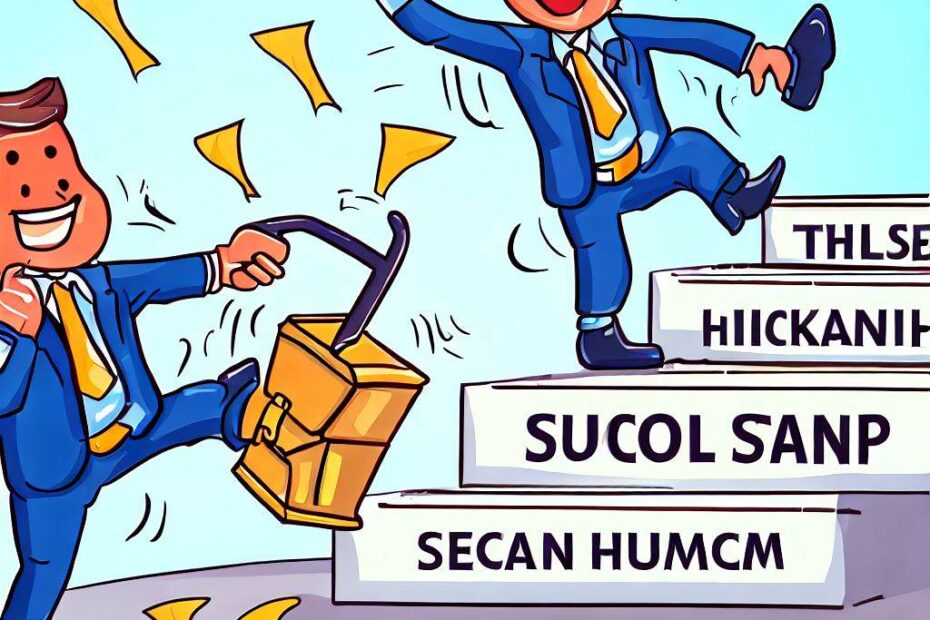Successful high ticket sales closing often involves breaking down the process into manageable mini-steps to increase transparency and streamline communication, as the complexities of the closing process can be daunting for many salespeople and often result in missed opportunities. However, the concept of Mini-Steps offers a revolutionary approach to address these challenges. In this comprehensive guide, we will explore the role of Mini-Steps in the closing process, their significance, and how they can enhance sales effectiveness. By implementing Mini-Steps, salespeople can improve their understanding of client engagement, streamline the sales process, and ultimately increase their success in closing deals.
The Role of Mini-Steps in the Closing Process: A Comprehensive Guide

In sales, closing deals is an essential part of ensuring business success. However, many salespeople find themselves struggling to navigate the complex processes involved in closing a sale. It’s not uncommon for salespeople to keep the selling, executing, and follow-up processes to themselves, without sharing them with their clients. This lack of transparency can lead to misunderstandings, miscommunications, and ultimately, lost sales.
Enter Mini-Steps, a revolutionary strategy designed to break down the often-hidden pursuit of closing and servicing steps involved in the sales process into ‘Mini-Steps’ that are shared on a timeline with the client. In this article, we explore the role of Mini-Steps in the closing process, what they entail, and how they can help you close more deals.
What Are Mini-Steps?
In simple terms, Mini-Steps are identifiable steps that need to be taken by the client, the salesperson, the company, or an outside party before, during, and after the sale. These steps can be internal-process oriented (e.g., filling out a credit application), creative-development oriented (e.g., scheduling a brainstorming session with your team), follow-up oriented (e.g., a post-buy client review), or any number of other areas that we’ll discuss in greater detail later on.
In essence, Mini-Steps are physical, action-oriented steps taken by the client, the salesperson, or a third party that are put on a timeline of Before, During, and After the sale. The goal of Mini-Steps is to move the closing process from the verbal to the physical, as clients will now prove how ‘interested’ they are through their actions and not just their words.
Why Mini-Steps Are Important
One of the main reasons why Mini-Steps are important is that they give salespeople several opportunities to ‘take the client’s temperature’ during their time in the sales pipeline process. If the client won’t take a simple action-oriented Mini-Step early on, it’s a clear sign that something has happened inside that client’s decision-making process (e.g., not getting consensus, someone has ‘poisoned the well,’ etc.)
Moreover, Mini-Steps show the client that the salesperson has a much more thorough process before, during, and after the sale. This will make the competition look lazy and weak in comparison. Additionally, Mini-Steps remove the client from the market by tying him down to a course of action early. Once steps are taken, it’s much harder to undo those steps and go in another direction.
How to Implement Mini-Steps
To implement Mini-Steps effectively, you must break down the different stages involved in the sales process into specific action steps. This may seem like an unnatural thing to do, but it’s essential if you want to streamline your sales process and close more deals.
Start by listing out all the identifiable steps in the sales process. These could include anything from scheduling a meeting to ordering a part, penciling in something on a calendar, or filling out a credit application. Next, organize these steps into a timeline of Before, During, and After the sale.
During the selling process, be sure to share the Mini-Steps timeline with your clients. This will give them a better understanding of what’s involved in the sales process, and it will set expectations for both parties. Moreover, it will help prevent misunderstandings and miscommunications, as everything will be outlined explicitly.
Tips for Using Mini-Steps
To use Mini-Steps effectively, keep the following tips in mind:
- Be clear and concise: Communication is key, so be sure to communicate with your clients clearly and concisely. Make sure they understand what’s expected of them and what they can expect from you.
- Use Mini-Steps to build trust: By being transparent and sharing the sales process with your clients, you’ll build trust and credibility, which can go a long way towards closing more deals.
- Don’t be afraid to pivot: If for whatever reason, a particular Mini-Step is not working out, don’t be afraid to pivot and adjust your strategy accordingly. The goal is to find what works best for you and your clients.
- Always be prepared: Make sure you’re always prepared for any potential roadblocks or obstacles that may arise during the sales process. The more prepared you are, the smoother the process will be.
Final Thoughts
Mini-Steps are a powerful tool that can help salespeople streamline their sales process, close more deals, and build stronger relationships with clients. By breaking down the different stages involved in the sales process into specific action steps, salespeople can turn the often-hidden pursuit of closing and servicing steps into a transparent, collaborative process shared by both parties. By implementing Mini-Steps effectively, salespeople can build credibility, trust, and ultimately, more successful business relationships.
Navigating Client Interactions – Unveiling the Truths of Salesmanship

As a salesperson, it can be challenging to navigate the unpredictable landscape of client interactions. Without a clear understanding of their motivations and thought processes, it can feel like a guessing game. However, if you take the time to learn about how clients are likely to act and respond in different situations, you can gain a significant advantage.
Here are some truths you need to know about clients:
1. Clients lie to avoid conflict
One of the most common tactics that clients use is lying to avoid conflict. They may not even think of it as lying at the time. The lies can range from slight deceptions like “I’ll take a look at it…” to flat-out lying, such as “I talked to a few other people, and they weren’t crazy about it.”
It’s essential to be aware of this behavior because it can impact your ability to close the sale. If a client is lying to avoid conflict, they may not be truly interested in what you’re offering. In these situations, it’s important to push for an honest answer and move on if necessary.
2. Clients act more interested than they really are
Another common behavior among clients is acting more interested than they actually are. They know that salespeople want to hear good news, so they’ll feign interest to keep the process moving along smoothly. This can be frustrating for salespeople who genuinely believe they have a good chance of closing the sale.
To combat this behavior, it’s important to read between the lines and understand when a client is just going through the motions. Pay attention to their body language and tone of voice, and don’t be afraid to ask clarifying questions to gauge their level of interest.
3. Clients say “maybe” when they really mean “no”
When a client says “maybe,” it’s easy to interpret that as a sign of interest. However, in many cases, it’s actually a polite way of saying “no.” Clients often use this tactic to avoid conflict and keep the salesperson engaged in the hope that they might change their mind.
To avoid falling into this trap, it’s important to ask specific questions to determine where a client stands. Don’t assume that a “maybe” is a sign of interest – instead, dig deeper to understand their true level of interest.
4. The nicer you are, the harder they may lie
Finally, it’s worth noting that being too nice can actually work against you in the sales process. If a salesperson is a jerk, a client may have no problem telling them to go pound sand. However, if you’ve built a strong relationship with a client, it can be harder for them to be honest about their lack of interest.
In these situations, it’s important to maintain a professional demeanor while also pushing for an honest answer. Don’t let your desire to please the client cloud your judgment or prevent you from closing the sale.
Understanding the behaviors and motivations of clients is critical to success in sales. By being aware of common tactics like lying, feigning interest, and using “maybe” as a polite rejection, you can better position yourself to close deals and build strong relationships with clients. Just remember to remain professional and persistent, even when faced with challenging situations.
Navigating the Complexities of the Salesperson-Client Relationship: Concrete Actions and Mini-Steps in the Closing Process

The relationship between salespeople and clients can be a complicated one, particularly when it comes to the closing process. Salespeople and deceptive clients often engage in a cycle of behavior that can be detrimental to both parties. Clients may pretend to be interested in a product or service to avoid conflict, while salespeople accept these feigned expressions of interest without questioning them because they want to maintain a full pipeline of prospective clients. This dynamic is akin to that of an addict and their supplier – both parties may get what they need in the short term, but the end result is destructive.
One of the primary issues with this dynamic is that salespeople tend to rely heavily on verbal commitments from clients rather than concrete actions. This can lead to misunderstandings and miscommunications that can cause problems down the line. Instead, salespeople should focus on creating a set of concrete actions that they can lead the client through. By doing so, they can gain a more accurate understanding of where the client is in the closing process and whether the sale is still on track.
There are several commonalities that tend to arise when using a two-step process for sales and closing. Clients may not fully understand the sales process and will often follow the salesperson’s lead. If the salesperson doesn’t take the initiative, clients may hesitate to make decisions. Additionally, many of the tasks involved in the sales process are done behind the scenes and aren’t shared with clients. Advancement is typically handled verbally, with salespeople asking vague questions like “How does that sound?” to which clients respond with similarly ambiguous answers. Firm timelines are often lacking, with clients providing generalities like “fairly soon” or “early fourth quarter.”
Breaking the two-step process down into mini-steps can help address some of these common challenges. By creating multiple opportunities to close the client on action steps, salespeople can gain a better understanding of where the client stands in the closing process. This can help them determine whether the sale is still on track or if further action is needed.
The relationship between salespeople and clients in the closing process can be complex and fraught with challenges. By focusing on concrete actions rather than verbal commitments and breaking the process down into mini-steps, salespeople can gain a better understanding of where their clients stand and improve their chances of closing the sale.
Conclusion
Navigating the sales process and client interactions can be a complex endeavor for salespeople. However, by understanding the truths about client behavior and employing concrete actions through Mini-Steps, salespeople can gain a significant advantage. Mini-Steps provide transparency, build trust, and help salespeople gauge client interest and commitment. By breaking down the sales process into identifiable steps and sharing them with clients, salespeople can streamline the process, reduce misunderstandings, and ultimately close more deals. By recognizing and implementing the power of Mini-Steps, salespeople can navigate the complexities of the salesperson-client relationship with confidence and achieve greater success in their sales endeavors.
